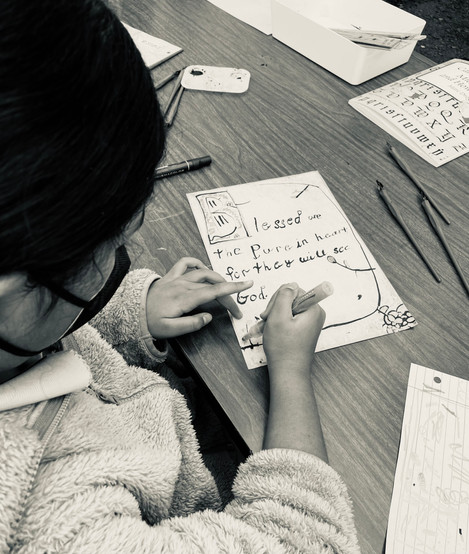Academy Highlights | Session III, Week 3
- Donum Dei
- Jan 20, 2022
- 3 min read
Grammar School Highlight | 4th Grade With Mrs. Gast
In History, we are studying the Renaissance and the Middle Ages. This includes studying several of the great saints of our faith. We began our year studying the life and works of St. Augustine. We also studied St. Jerome and most recently we learned about St. Benedict. During the time of St. Benedict, monks who had previously lived as hermits in the wilderness, began to move into communities together, called monasteries. St. Benedict wrote rules for how monks were expected to live holy lives in monastic communities.
Among other things, the monasteries became educational centers. Movable type had not yet been invented, and printing was not known in Europe at this time. Books had to be written by hand, and the monks and nuns who had reading and writing skills were the ones to do this job. More graceful and dramatic lettering designs were created during the Middle Ages than at any other time.
The fourth graders set out to try their hand at lettering. They practiced writing with calligraphy pens and ink, making careful letter strokes and embellishing their pages with gold. Because much of the copying and writing that took place in the monasteries was the scriptures, we practiced writing the Beatitudes of Jesus. St. Benedict came up with three rules for holy and monastic living, but Jesus came to set us free from the law and gave us eight blessings to truly teach us how to live at peace.
Upper School Highlight | Bible Narrative With Rev. Yeager
You might ask yourself, "Why do we call this class Bible Narrative? Why not just Bible Class?" It's a good question to ask! As I often tell my students, it's always good to ask basic questions like "why?" because, while we might be afraid, the Bible is never afraid of questions. We call this class Bible Narrative because both of these words are of upmost importance to our study of our faith and world.
The Bible is central to the Christian faith. Important church teachers and leaders of old often called the Bible the language of the church. It shapes much of what it means to be a Christian. An important question to ask, "How does it do this?" Another brilliant question! And you might guess where I'm going...it shapes us through narrative.
The Bible is one big narrated story of the entire cosmos. Its aim is to shape the stories of the people who confess and follow the Almighty God: Father, Son, and Holy Spirit. Here's a recent example of how the Biblical story is shaping this class:
A few weeks ago, we read and slowly worked through the content of 2 Samuel 12. In this story, the prophet Nathan confronts King David of his disastrous actions of adultery with Bathsheba and his intentional set up of the death of her husband. The Bible certainly does not hide the nasty faults of man. But how does Nathan confront David? The students rightly observed that he tells David a little story.
It's a very simple story that Nathan tells. Once upon a time, there were two men. One was rich and had an abundance of crops and animals; the other man was poor and only had a little, young lamb. The poor man absolutely adored this lamb: he fed it with his own food, shared his bed with it, and treated it like his own child. Well, a traveler came into town and the rich man wanted to throw a feast for him. Did he take from his abundance to feed this feast? No. He grabbed the poor man's little lamb, slaughtered, and roasted it to feed at his feast.
David's response is, "This rich man deserves to die!" Nathan's response, "You are that man." David is undone; he confesses his sin, prays, fasts, and weeps.
Stories have the power to sneak behind the walls we put up, and the ability to undo the false tales we, or our culture, constructs. We need good, true stories to pierce through our crooked hearts and cleanse us from the cheap charades that surround us day to day. We need the Biblical story—its truth, goodness, and beauty—to shape our own story.
_edited_edited_edited.png)



































Comments